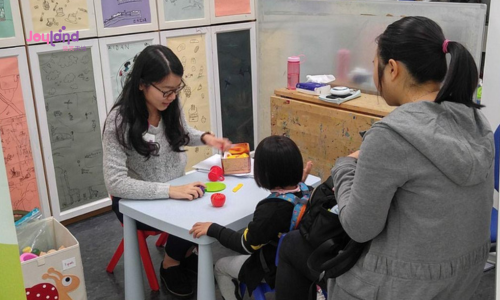Dyslexia, Speech and Language Therapy 失讀症及讀寫障礙



Dyslexia, Speech and Language Therapy 失讀症及讀寫障礙

What is Dyslexia, Speech and Language Therapy?
Dyslexia, Speech and Language Therapy is a healthcare profession focused on diagnosing and treating communication disorders, speech impairments, and language difficulties in individuals of all ages. You may consider speech therapy if you experience challenges in speaking clearly, understanding language, stuttering, voice disorders, or difficulty swallowing. Consulting a speech therapist can help assess and address these concerns effectively.
Key features of Dyslexia:
– Reading Difficulties: Struggles with decoding words, slow or inaccurate reading.
– Spelling and Writing Challenges: Frequent spelling errors, difficulty organizing written language.
– Phonological Processing Issues: Trouble recognizing and manipulating sounds in words (e.g., rhyming, blending sounds).
– Unexpected Discrepancy: Reading abilities lag behind other skills like reasoning or problem-solving.
Ideal Age for Therapy?
Speech therapy can benefit individuals of all ages. Early intervention, typically starting in early childhood, is often recommended for better outcomes in addressing speech and language delays or disorders.
Reason why need Speech and Language Therapy?
Speech and Language Therapy is crucial for improving communication skills, enhancing social interactions, addressing swallowing difficulties, and boosting overall quality of life for individuals experiencing speech and language challenges.
What are the clinical manifestations or signs?
Signs that may indicate the need for speech therapy include difficulty pronouncing words, limited vocabulary, struggling to follow instructions, stuttering, voice hoarseness, and challenges with social communication.
How can a diagnosis be confirmed?
A speech therapist assesses an individual’s speech and language abilities through various tests, observations, and evaluations to confirm the presence of communication disorders and determine the appropriate treatment plan.
Therapy & treatment?
Speech therapy involves a range of interventions tailored to individual needs. Activities such as tongue and mouth exercises, facial movements, reading out loud, and playing word games etc are commonly utilized to improve speech and language skills.
– Articulation Drills: Articulation drills involve practicing specific speech sounds to improve pronunciation and clarity. Therapists may use flashcards, mirrors, or speech sound cues to help individuals correctly produce challenging sounds.
– Conversation Practice: Engaging in conversation practice allows individuals to work on expressive language skills, turn-taking, topic maintenance, and social communication. Therapists guide clients through structured conversations to enhance communication abilities in real-life situations.
– Voice Therapy Exercises: Voice therapy exercises focus on improving vocal quality, pitch, volume, and resonance. Activities may include vocal warm-ups, breathing exercises, pitch modulation exercises, and strategies to reduce vocal strain.
– Language Comprehension Tasks: Language comprehension tasks involve activities that target understanding and processing spoken language. These tasks may include following directions, answering questions based on auditory information, and identifying key details in a passage.
– Narrative Building: Narrative building activities help individuals develop storytelling skills, sequencing abilities, and cohesive language expression. Clients may be guided to create and narrate stories, retell events, or summarize information in a structured manner.
– And many more…
How to Avoid?
To prevent speech and language difficulties, maintaining good oral hygiene, practicing proper vocal hygiene, and seeking early intervention for any concerns can be beneficial.
Assessment Process?
The assessment process typically involves a comprehensive evaluation of an individual’s speech, language, voice, and swallowing abilities to identify areas of difficulty and create a personalized treatment plan.
Interventions implemented by the Speech Therapist for resolution.
Speech therapists implement various interventions, including articulation therapy, language intervention, voice therapy, fluency therapy, and swallowing therapy, to help individuals improve their communication skills and overall quality of life.
失讀症及讀寫障礙
失讀症、讀寫障礙及言語及語言治療是一門專注於診斷和治療所有年齡段個人的溝通障礙、言語障礙和語言困難的醫療專業。如果您在清晰表達、理解語言、口吃、聲音障礙或吞嚥困難方面遇到挑戰,您可以考慮接受言語治療。諮詢言語治療師有助於有效評估和處理這些問題。
失讀症的主要特點:
– 閱讀困難:解碼單詞困難,閱讀速度緩慢或不準確。
– 拼字和書寫挑戰:拼寫錯誤頻繁,書寫語言組織困難。
– 聲音處理問題:難以識別和操作單詞中的聲音(例如,韻律、混合聲音)。
– 意外差異:閱讀能力落後於推理或解決問題等其他技能。
治療的理想年齡?
言語治療對所有年齡段的個人都有益處。早期干預通常從幼兒時期開始,這通常會為解決言語和語言延遲或障礙帶來更好的結果。
為什麼需要失讀症及讀寫障礙治療?
失讀症及讀寫障礙治療對於改善溝通技巧、增強社交互動、解決吞嚥困難,以及提高面對言語和語言挑戰的個人的整體生活質素至關重要。
有哪些臨床表現或徵象?
可能表明需要言語治療的徵象包括詞語發音困難,詞彙量有限,難以遵循指示,口吃,聲音嘶啞,以及社交溝通方面的挑戰。
如何確診?
言語治療師通過各種測試、觀察和評估來評估個人的言語和語言能力,確認溝通障礙的存在並確定適當的治療計劃。
如何治療?
言語治療涉及一系列根據個人需求量身定制的干預措施。常用的活動包括舌頭和口腔練習、面部運動、大聲朗讀和玩文字遊戲等,以改善言語和語言技巧。
– 發音練習:發音練習包括練習特定的語音以改善發音和清晰度。治療師可能會使用字卡、鏡子或語音提示來幫助個人正確發出具有挑戰性的聲音。
– 對話練習:進行對話練習可以讓個人提高表達語言技巧、輪流發言、保持話題,以及社交溝通。治療師會引導客戶進行結構化對話,以增強溝通能力,應用於現實情況中。
– 聲音治療練習:聲音治療練習旨在改善聲音質量、音高、音量和共鳴。活動可能包括聲音熱身、呼吸練習、音高調節練習,以及減少聲音負擔的策略。
– 語言理解任務:語言理解任務涉及針對理解和處理口語語言的活動。這些任務可能包括遵循指示、根據聽到的信息回答問題,以及在段落中識別關鍵細節。
– 敘事能力培養:敘事能力培養活動幫助個人發展講故事技能、順序能力和連貫的語言表達。客戶可能會被引導創建和敘述故事、講述事件,或以結構化方式總結信息。
– 還有更多…
如何預防?
要預防言語和語言困難,保持良好的口腔衛生、練習正確的聲音衛生,並對任何問題尋求早期干預都是有益的。
評估過程?
評估過程通常涉及對個人的言語、語言、聲音和吞嚥能力進行全面評估,以確定困難領域並制定個性化的治療計劃。
言語治療師治療措施
言語治療師實施各種治療措施,包括發音治療、語言干預、聲音治療、流暢治療和吞嚥治療,幫助個人改善其溝通技巧和整體生活質素。
Features
- - Comprehensive overview of Speech and Language Therapy.
- - 本中心提供全面的失讀症及讀寫障礙訊息及專業治療。
- - Signs indicating the need for intervention, diagnosis process, therapy activities and strategies for prevention.
- - 我們有明確的方向來表明介入的必要性、診斷過程、治療活動和預防策略。
Target audiences
- - Individuals seeking information on Speech and Language Therapy, caregivers, educators, healthcare professionals, and anyone interested in understanding communication disorders and their treatment.
- - 尋求有關言語治療,失讀症及讀寫障礙的患者、照顧者、教育工作者、醫護專業人員,以及任何對了解溝通障礙及其治療感興趣的人士。
- - School-based Speech Therapy Service for Kindergarten, primary and secondary schools
- - 為幼稚園、小學和中學提供學校專屬的言語治療服務。
FAQs
Instructor
Address communication disorders, articulation, language development, and more.
© 2025 Copyright @ 2025 Joyland Hong Kong.
